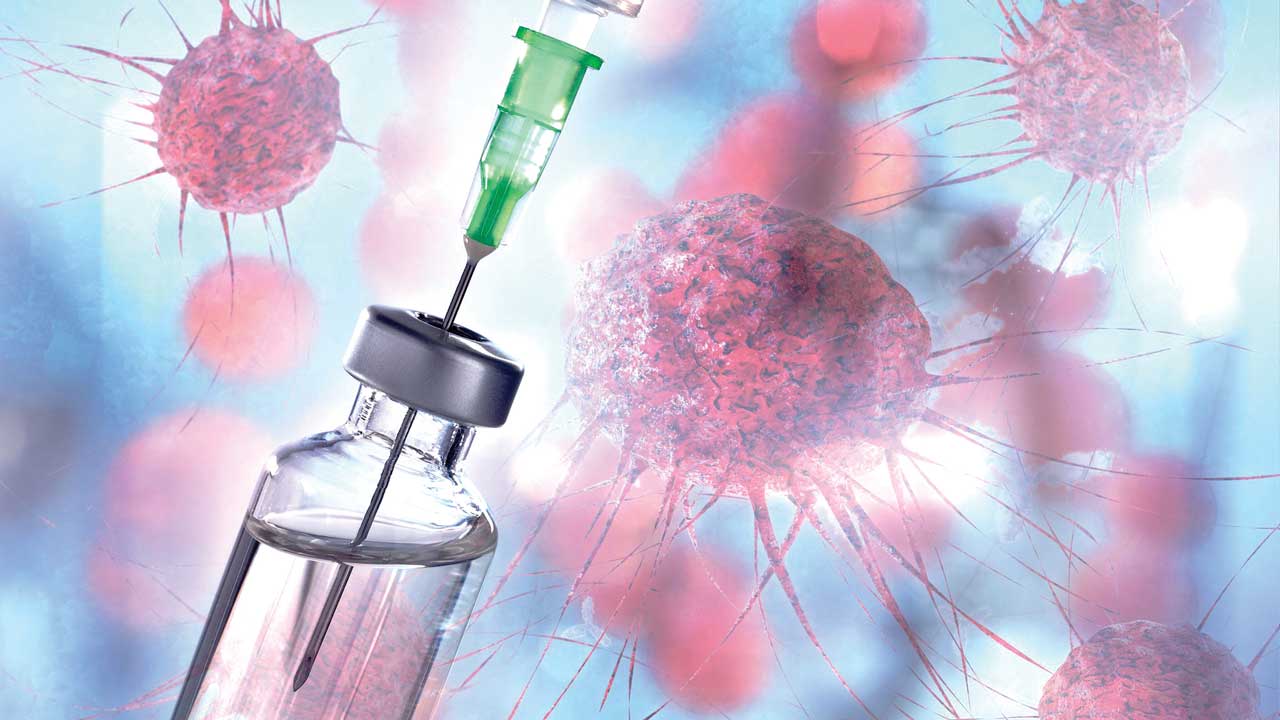 •Vaccines to treat cancer possible by 2030, say BioNTech, Merck, Moderna
•Vaccines to treat cancer possible by 2030, say BioNTech, Merck, Moderna
•Thousands of pancreatic cancer patients die early ‘because their disease is missed on scans’
•Hair-straightening chemical products linked to increased uterine cancer risk in new study
Pharma giants Merck and Moderna have teamed up to develop a cancer vaccine that is based on the same tech used in COVID-19 shots.
The new shot — designed for people with high-risk melanoma — is in the second of three trials and a verdict on whether it works or not is expected within months.
It harnesses mRNA technology that uses pieces of genetic code from patients’ tumors to teach the body to fight off the cancer.
The vaccine is given to people post-surgery to prevent the tumor from returning, and it is tailored to each patient, meaning no two shots will be the same.
This means it could be hugely expensive. Similar cancer vaccines being trialed cost around $100,000 (£91,000) to make each individual shot.
Merck and Moderna will share the production and commercial costs and split the profits if it goes to market. The collaboration has got markets excited, sending Moderna’s shares soaring 16 per cent Wednesday.
MRNA is leading the frontier of potential cancer cures after the tech was rapidly accelerated during the pandemic, leading to the two most successful COVID-19 vaccines — made by Pfizer and Moderna.
As part of the updated deal, Merck will pay $250million to Moderna for joint rights to the cancer vaccine.
The two drug makers have been running trials of the shot together after forming a ‘strategic partnership’ in 2016.
In the latest phase 2 study, 157 patients given personalized vaccines alongside Merck’s immunotherapy drug Keytruda.
Also, according to the husband and wife team behind one of the most successful COVID-19 vaccines of the pandemic, vaccines that target cancer could be available before the end of the decade.
Uğur Şahin and Özlem Türeci, who co-founded BioNTech, the German firm that partnered with Pfizer to manufacture a revolutionary mRNA COVID-19 vaccine, said they had made breakthroughs that fuelled their optimism for cancer vaccines in the coming years.
Speaking on the BBC’s Sunday with Laura Kuenssberg, Prof. Türeci described how the mRNA technology at the heart of BioNTech’s COVID-19 vaccine could be repurposed so that it primed the immune system to attack cancer cells instead of invading coronaviruses.
Asked when cancer vaccines based on mRNA might be ready to use in patients, Prof Sahin said they could be available “before 2030”.
An mRNA COVID vaccine works by ferrying the genetic instructions for harmless spike proteins on the COVID virus into the body. The instructions are taken up by cells, which churn out the spike protein. These proteins, or antigens, are then used as “wanted posters” – telling the immune system’s antibodies and other defences what to search for and attack.
The same approach can be taken to prime the immune system to seek out and destroy cancer cells, said Türeci, BioNTech’s chief medical officer. Rather than carrying code that identifies viruses, the vaccine contains genetic instructions for cancer antigens – proteins that stud the surfaces of tumour cells.
BioNTech was working on mRNA cancer vaccines before the pandemic struck but the firm pivoted to produce COVID-19 vaccines in the face of the global emergency. The firm now has several cancer vaccines in clinical trials. Türeci said the development and success of the Pfizer/BioNTech vaccine, which is similar to the Moderna COVID shot, “gives back to our cancer work”.
The German firm hopes to develop treatments for bowel cancer, melanoma and other cancer types, but substantial hurdles lie ahead. The cancer cells that make up tumours can be studded with a wide variety of different proteins, making it extremely difficult to make a vaccine that targets all of the cancer cells and no healthy tissues.
Türeci told Kuenssberg that BioNTech had learned how to manufacture mRNA vaccines faster during the pandemic, and had a better understanding of how people’s immune systems responded to mRNA. The intense development and rapid rollout of the COVID-19 shot had also helped medicines regulators work out how to approve the vaccines. “This will definitely accelerate also our cancer vaccine,” she added.
But Türeci remained cautious about the work. “As scientists we are always hesitant to say we will have a cure for cancer,” she said. “We have a number of breakthroughs and we will continue to work on them.”
In August, Moderna said it was suing BioNTech and its partner, the US pharmaceutical giant Pfizer, for patent infringement over the company’s Covid-19 vaccine.
Asked about that, Sahin said: “Our innovations are original. We have spent 20 years of research in developing this type of treatment and of course we will fight for our intellectual property.”
Also, a damning study has warned that thousands of patients are dying early because pancreatic cancer is being missed on scans.
More than a third of pancreatic cancer cases (36 per cent) were potentially avoidable if they had been picked up sooner, researchers found.
But the UK study found many patients were being denied potentially curative surgery because signs were not being picked up after scans.
Researchers examined 600 scans of people diagnosed with pancreatic cancer at two NHS trusts in England between 2019 and 2021.
They found almost one in 12 were categorised as post-imaging pancreatic cancer (PIPC) cases – when a patient undergoes an MRI or CT scan that fails to pick up cancer before later being diagnosed.
In almost half (48 per cent) of PIPC patients examined, there were signs of cancer that had been missed when scans were reviewed by a specialist hepatobiliary radiologist.
More than a quarter (28 per cent) signs associated with pancreatic cancer, such as dilated bile or pancreatic ducts, were not recognised and investigated further.
Dr. Nosheen Umar, lead author of the study, from the University of Birmingham, said the oversights were costing lives.
“There is often only a very short period for curative surgery in pancreatic cancer, meaning it is vital that patients are diagnosed with the disease as early as possible to give them the best chance of survival,” he said.
“The study found that evidence of pancreatic cancer was initially missed in over a third of patients with post-imaging pancreatic cancers, which is a huge window of lost opportunity.
“We hope this study will raise awareness of the issue of post-imaging pancreatic cancer and common reasons why pancreatic cancer can be initially missed.
“This will help to standardise future studies of this issue and guide quality improvements efforts, so we can increase the likelihood of an early diagnosis of pancreatic cancer, increase the chances of patient survival and, ultimately, save lives.”
Pancreatic cancer kills around 9,600 people in the United Kingdom (U.K.) every year, with around 10,500 newly diagnosed.
The disease kills roughly 50,000 in the United States (U.S.) yearly, with around 62,000 people getting diagnosed.
As one of the hardest cancers to spot and treat, only a quarter survive beyond a year after diagnosis.
The review, presented at United European Gastroenterology (UEG), found 48 patients failed to have their cancer picked up through their first scan but were diagnosed between three and 18 months later.
Experts said more needs to be done to spot tumours at an earlier stage before the cancer has spread.
Chris Macdonald, head of research at Pancreatic Cancer UK, said: ‘Pancreatic cancer is hard to diagnose, however detecting this devastating disease at an earlier stage, where treatment is most like to be effective, is crucial.
“It is worrying to see the results of this study, which has shown that 36 per cent of pancreatic cancer tumours in the study group could have been diagnosed earlier.
“We know that because of cancer location, imaging pancreatic cancer, especially at its earliest stages when small, is very challenging.
“This study clearly illustrates that challenge and highlights the need for improvements in imaging techniques.
“It also demonstrates that radiologists need more tools and support to ensure that we increase the likelihood of tumours being identified at the earliest possible stage.”
Also, scientists are uncovering new details in the connection between using certain hair straightening products, such as chemical relaxers and pressing products, and an increased risk of cancer in women.
Ongoing research previously suggested that hair straightening chemicals are associated with an increased risk of certain hormone-related cancers, including breast and ovarian cancers, and now, a new study links use of hair straightening products with an increased risk of uterine cancer. Black women may be more affected due to higher use of the products, the researchers noted.
The study, published Monday in the Journal of the National Cancer Institute, estimates that among women who did not use hair-straightening chemical products in the past 12 months, 1.6 per cent developed uterine cancer by age 70, but about four per cent of the women who frequently use such hair-straightening products developed uterine cancer by age 70.
That finding “also communicates that uterine cancer is indeed rare. However, the doubling of risk does lead to some concern,” said Chandra Jackson, an author of the study and researcher at the National Institute of Environmental Health Sciences.
“In this study, women with frequent use in the past year had an over two-fold higher risk of uterine cancer,” she said. Frequent use was defined as more than four times in the previous year.
The new study includes data on nearly 34,000 women in the United States, ages 35 to 74, who completed questionnaires about their use of certain hair products, including perms, dyes, relaxers and straighteners. The researchers, from the National Institutes of Health, also tracked the incidence of cancer diagnoses within the study group.
The researchers found a strong association between hair straightening products and uterine cancer cases but the use of other hair products – such as dyes and perms or body waves – was not associated with uterine cancer.
The study data also showed that the association between hair straightening products and uterine cancer cases was most pronounced for Black women, who made up only 7.4 per cent of the study participants, but 59.9 per cent of those who reported ever using straighteners.
Several factors likely play a role in the frequent use of hair straightening products: Eurocentric standards of beauty, social pressures placed on Black and Latina women in workplace settings related to microaggressions and the threat of discrimination, along with desired versatility in changing hairstyles and self-expression.
“The bottom line is that the exposure burden appears higher among Black women,” Jackson said.
“Based off of the body of the literature in this area, we know that hair products marketed directly to Black children and women have been shown to contain multiple chemicals associated with disrupting hormones, and these products marketed to Black women have also been shown to have harsher chemical formulations,” she said. “On top of that, we know that Black women tend to use multiple products simultaneously, which could contribute to Black women on average having higher concentrations of these hormone-disrupting chemicals in their system.”
The researchers did not collect information on brands or ingredients in the hair products the women used, but they wrote in the paper that several chemicals identified in straighteners could contribute to the increased incidence of uterine cancer observed in their study.
“To our knowledge this is the first epidemiologic study that examined the relationship between straightener use and uterine cancer,” Alexandra White, head of the National Institute of Environmental Health Sciences Environment and Cancer Epidemiology group and lead author on the study, said in a news release Monday.
“More research is needed to confirm these findings in different populations, to determine if hair products contribute to health disparities in uterine cancer, and to identify the specific chemicals that may be increasing the risk of cancers in women.”
Some substances found in hair-straightening products, especially those most used by and marketed to Black and Latina women, are hormone-disrupting chemicals, said Tamarra James-Todd, an epidemiologist at Harvard T.H. Chan School of Public Health, who was not involved in the new study but separately has led some of the earliest research finding links between hair products and cancer.
“They modify our body’s normal hormonal processes. So, it makes sense to look at cancers that are hormonally mediated,” she said, adding that hormone-disrupting chemicals could impact other parts of the body too.
“The challenge is that the impact of these chemicals might not be limited to hormonal processes, but they could also impact other systems, including our immune and vascular systems. Understanding how these chemicals work beyond the hormonal system is still a new and growing area of research,” James-Todd told CNN.
“So, it could be that the way these chemicals are operating is through altering not only hormonal responses, but also by altering immune or even vascular responses,” she said. “All of these processes are linked to cancer.”
While the new study is “well done” and shows an association between hair-straightening chemical products and increased uterine cancer risk, it is unable to determine that the products directly cause the cancer, Dr. Otis Brawley, professor at the Johns Hopkins University Bloomberg School of Public Health and former chief medical officer of the American Cancer Society, said in an email to CNN.
“It is unable to show cause, it could be pure association,” said Brawley, who was not involved in the new study.
Yet “the question how do we settle this is difficult. The scientific ideal is a randomized trial of 40,000 or so; 20,000 with regular hair straightener use and 20,000 never using it and never having used it and follow them for 20 years,” he said, adding that at this point, “it’s impossible for science to answer better than” the recent study.






